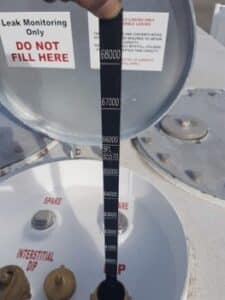Dip your Fuel Storage Tank to Maintain Fuel Quality
A quick dip of your fuel tank is a must for any business that relies on vehicles. After all, you can’t afford to take chances with fuel quality.
Testing fuel quality regularly saves your business tens of thousands of dollars. And all it takes is a quick dip check of your fuel tank.
Maintaining your fuel and your fuel tanks is critical to keeping your fleet running at optimal levels. So how often should you dip your fuel tank?
Why should I dip my fuel tank?
Regular dipping ensures you can detect fuel loss early and take action to stop it.
Dipping your fuel tanks is good business practice because it reconciles the fuel left in your tank with what has been sold out of the bowser, and will quickly pick up any discrepancies. This means you know quickly if you are losing fuel through leakage, theft or poorly calibrated dispensing systems.
A leaking fuel tank not only impacts your business by reducing your supply levels – if left undetected, it can mean serious safety issues and significant fines from local regulators.
There’s also the case of checking on where leaks are coming from. Particularly if you own an older fuel tank. Many older underground tanks have suction lines that run close to the bottom of the tank, increasing the chance of sucking water or silt into vehicles and causing damage. This damage then increases the chance of leaks forming over time.
There’s also the case of monitoring silt levels too. Silt forms at the bottom of tanks slowly as fuel breaks down when stored over long periods of time. When a truck goes to unload its product and pump it into the tank, this silt may get stirred up. If it gets into the customer’s vehicle, it may cause blocked filters and potentially more serious issues.
Keeping a close watch on the levels in your fuel storage tanks keeps your fuel in good condition and prevents these issues from occurring.
Fuel dipping can detect water and pollutants in your fuel storage tanks.
If water gets into your fuel supply, it can do serious damage to both your fuel supply and any vehicle carrying it,
Water contamination in fuel tanks can cause anything from intermittent power loss to engine failure. This could lead to anything from blown injectors to cracked components. This is a virtual nightmare for anyone fuelling an entire fleet of vehicles.
It also creates an ideal breeding environment for microbes which can degrade your fuel and cause phase separation, particulate contamination and tank damage. This is caused by acids from the microbes as they feed on the fuel.
Therefore, dipping your fuel tank can alert you to these issues and find ways to treat it.
So what will I check for when I dip my fuel tank?
Essentially, when you dip your fuel tank, you’ll be looking to ensure the fuel that is missing from your tank is equal to the amount you’ve distributed from your bowser or point of sale system.
You can keep a record of your levels with a fuel management system. If you’re supplying a fleet of vehicles, a good system will give you an early warning if a vehicle is not performing well or needs servicing.
You should also test for water by using a water-finding paste on your dipstick. Drain any excess water immediately to keep your fuel fresh and reduce the potential for microbial contamination.
Finally, using a fuel sample test kit is good practice to ensure your fuel is free from microbes and particulates.
How often should I dip?
For a commercial fuel supplier, it is to dip your fuel tanks daily to check fuel levels and test for water contamination. Ideally, you would also use a fuel sample test kit regularly and keep up regular inspections of and maintenance on your tanks and fittings.
If you only store a small amount of fuel and use it irregularly, you should always dip your tank and test for water before you fill it up. Suppose you store your fuel for long periods, for example for seasonal farm work. In that case, it’s worth taking a sample before you fill up machinery to avoid unplanned downtime and lost productivity due to damage and equipment failures caused by water or particulates in your supply.
What if I discover a problem?
Discovering any problems with your fuel tanks calls for immediate action. Should you discover a leak, quickly test to find the cause and look for the best solution to quell the leak.
If your fuel is contaminated, your tank will need to be filled and dosed with a biocide which will help address the problem. Using these will help kill off microbes and improve overall fuel quality
That’s why knowing how often you should dip your fuel tank is a basic but essential part of everyday fuel maintenance to save both time and money.
If it’s time to replace your tanks, F.E.S. TANKS has a complete range of fuel storage systems for sale or hire to suit all fuel storage needs.
Contact our industry experts to find out the best fuel storage options for your business.





6 Comments
How many days each month are you legally required to dip your under ground tank in a service station in South Australia
We don’t believe there to be legislation as to how often you must dip. The biggest consequence of not dipping is if you spring a leak in your tank and you have failed to find this leak in reasonable time you will be seen to be negligent by the authorities. So therefore if your tank ruptures and you find the leak in good time you have less risk of being fined by EPA.
Regular dips will also go along way to support maintenance records / logs i.e. evidence of regular human intervention etc.
Can dipping a gas station tank detect if diesel has contaminated the gasoline?
Where to buy this item?
How long should i leave the dipstick in the tank when doing dip. I am asking because i have a wooden dip stick, if i leave it too long will it soak up higher the dip stick or not. Dip stick is supplied by fuel service providers and calibrated by them
Dear Sir/Madam
At the company I work for we have 2200 ltr diesel tank and we only keep/store a maximum of 1500 ltr for a fleet of our forklifts.
Every time we top it up to it’s full capacity i.e. 2200 we start to experience a huge variance of about 150-200ltr.
What could be the main course of this problem?
I doubt it could be theft because we have CCTV (cameras) installed to record and monitor the movement around the diesel tank.
We top up 1500 ltr every 7 days but our tank dispenser doesn’t have the vapour recovery systems.
Please advise.
Kind regards